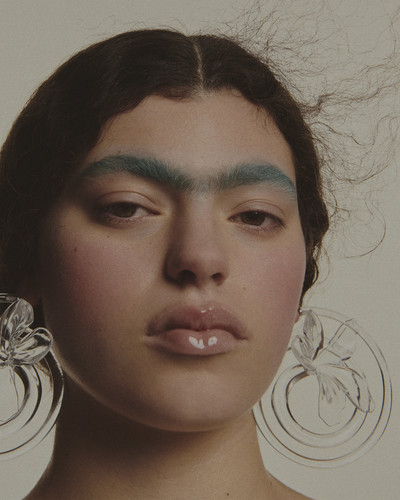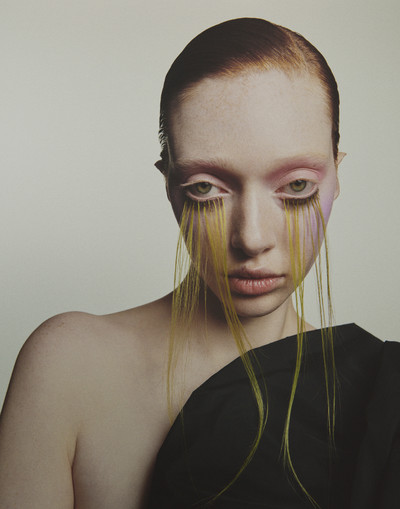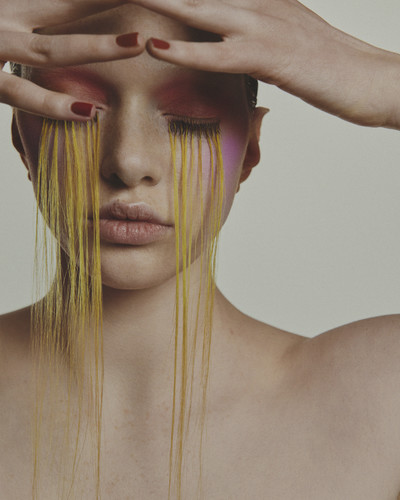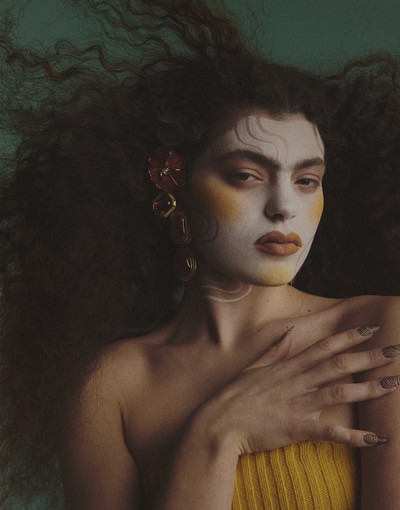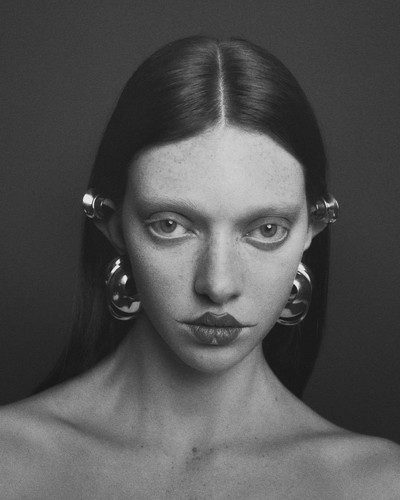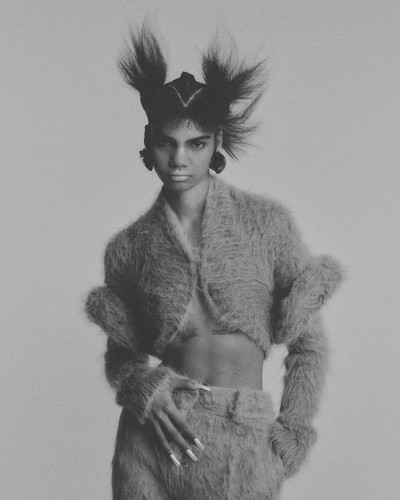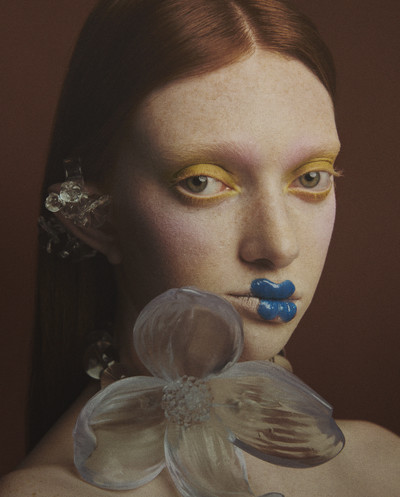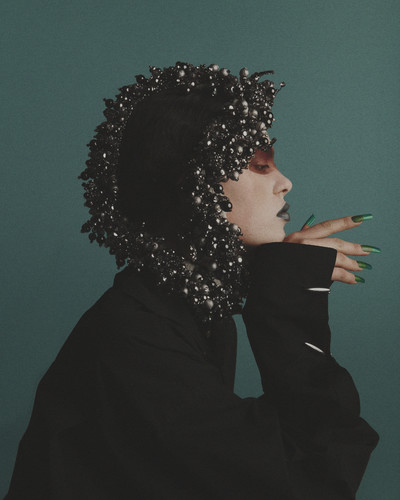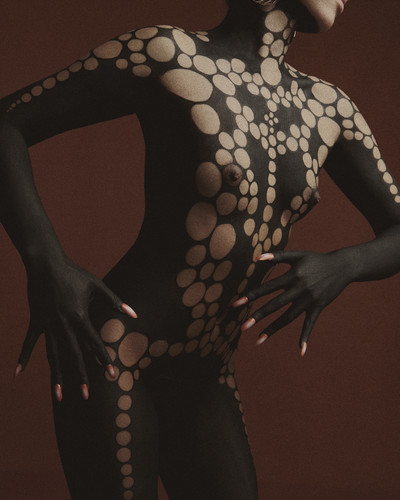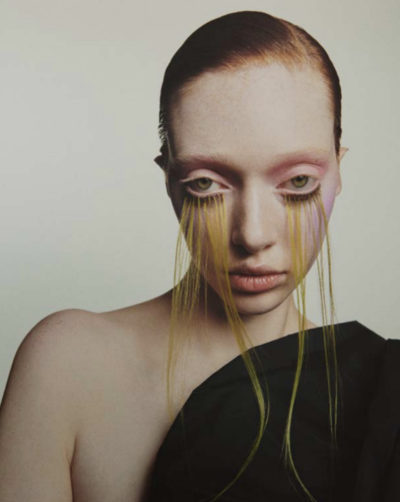Photographer Nadine Ijewere and make-up artist Ammy Drammeh on the rules of representation and how you know when a picture is the one.
Photographs by Nadine Ijewere
Make-up by Ammy Drammeh
Hair by Ali Pirzadeh
Photographer Nadine Ijewere and make-up artist Ammy Drammeh on the rules of representation and how you know when a picture is the one.
For photographer Nadine Ijewere and make-up artist Ammy Drammeh, to talk about beauty is to talk about representation. Inspired by her Nigerian and Jamaican heritage, much of Ijewere’s work celebrates the rich beauty of Black culture that she never saw represented in magazines growing up. After graduating from London College of Fashion with a degree in photography, in 2018 she became the first woman of colour to shoot the cover of Vogue in the magazine’s 125-year history. Since then, the South Londoner has created film and photography campaigns for Calvin Klein, Hermès, Louis Vuiton and Dior, and has participated in exhibitions at both Photo London and Tate Britain.
Drammeh followed a similar trajectory, growing up in Barcelona where diverse representation was also hard to come by. Forced to look elsewhere, Drammeh soon discovered make-up as a medium through which to communicate her own ideas about beauty. She moved to London in 2018, where she met Ijewere, and together with creatives such as stylist Ib Kamara, photographer Campbell Addy, and nail artist Ama Quashie formed a coterie of artists preoccupied with conversations surrounding diversity and challenging the industry’s norms. Continuing to buck the system, Drammeh’s emphasis on raw beauty and imperfection has seen her work with everyone from Bottega Veneta to Burberry, Gucci to Chanel, where she is currently Global Makeup Creative Partner.
Tish Weinstock: What did beauty look like to you growing up?
Nadine Ijewere: Growing up my first exposure to beauty and fashion was through my mum and her sisters, who were always buying magazines like Vogue. I grew up around Black women who had incredible hair and make-up styles – metallic lips and matching eyeshadow, the super thin eyebrows – and yet I wasn’t seeing this reflected in those photographs. When you’re young, you’re already so self-conscious of how you look, but when you’re constantly seeing images of people from a different background, where the hair is super straight, or they had lighter skin, it’s a bit of a woah moment. I was like, ‘Where do I sit?’ It has always been an ongoing thing for me where I have tried to assimilate to European standards. It was only when I reached 30 that I became more like, ‘Fuck it.’
Ammy Drammeh: Unfortunately, unlike Nadine, I didn’t have many Black female figures around me growing up. My dad is from Gambia, but my mum is from the south of Spain and I grew up in Barcelona where representation is still not even a thing now. Luckily I had two older brothers who were obsessed with music, so that is where a lot of my references came from: R&B, hip-hop and neo soul. I remember being aware of the dominant beauty trends in the late ‘90s and early 2000s, which were all to do with heroin chic, being extremely thin and having no curves. I developed really early and had a curvaceous figure, so I didn’t fit in with the beauty standards. It wasn’t until I went to places like Gambia and New York and got attention because of how I looked, that I realised we don’t all have the same notion of beauty.
How does make-up fit into all of this?
Ammy: I was very young when I first started experimenting with make-up. One of my classmates brought a copy of Kevyn Aucoin’s Face Forward into class and I asked to borrow it. I started practising all the different looks at home on my friends using my mum’s make-up. I would also do everyone’s make-up for school plays. Eventually my teachers told my parents that I should consider pursuing it as a career.
Nadine, when did you first pick up your first camera?
Nadine: My dad always had the latest gadgets, so I was exposed to that from an early age. I used to do cringe photoshoots with my friends, but in terms of an interest in real photography, that came when I studied it at A-level.
What do you hope to communicate in your work?
Ammy: At the beginning, all I wanted to do was have fun with make-up. Now I see it as a tool for empowerment. I want to show an idea of beauty which allows people to feel represented, and feel good. I also want to create characters and bring something a bit more cinematic into the mix.
Nadine: Initially I was just interested to see what fashion imagery would be like if there was more diversity. What would it be like if there was a Black woman as the main model, who hadn’t straightened her hair or didn’t have a light skin tone? Beauty is multifaceted; it’s not about one specific look and that’s always been a theme that underlines my work both in terms of casting and the teams I work with.
What about perfection?
Ammy: I don’t care about perfection, it’s not important to me. It’s not about creating perfect eyeliner or a perfect lip. It is about what that lip or eyeliner can communicate.
With that in mind, how do you know when a look is ‘right’ or complete? What are you basing your aesthetic judgement on if not an idea of perfection?
Ammy: You just feel it; you keep adding things and taking things away if it’s not right or if my eye is not happy with it. At the moment, there is a trend for hyper perfection on Instagram, where the skin is baked and highlighted in all the right places, the eyeliner is perfect and the eyebrows are thin and have been painted on. While I think it is beautiful, I don’t want that to be the only way of doing make-up. And that’s something we wanted to play with in our shoot.
Nadine: I’m the same as Ammy. There are elements in my work that are perfect, but that is more technical, like with lighting. Outside of that, I don’t want to communicate an idea of perfection, because then I would be doing exactly what those images did for me growing up with their idealised notions of beauty, hair type and skin colour. In terms of judging when I know a picture is the one, I’ll be looking through my lens and there will be a slight movement or an expression or even an energy and I will just feel it and I’ll capture it and will be like, ‘We have it’, but I can’t explain how or why that is.
Perfection is obviously a very loaded word, given its historical connotations. Do you think it’s something we should just do away with when it comes to discussing beauty today?
Nadine: I do think it’s the wrong word. It’s a man-made word that has been used for a very long time in society, probably by men who have decided what women should look like and aspire to.
Ammy: It’s outdated. Work should be about the feeling you get when you look at it, based on your tastes and preferences.
Both across fashion and beauty, more and more creatives are rejecting this idea of perfection, galvanised by calls for diversity and inclusivity. How do you think that is going to evolve? Is it just a trend?
Ammy: I hope it stays, but there is a pattern, and the pattern always continues, it will circle back to whatever it was before and then circle back again to what it is now. I think some things will stay, although even now you can see it on the catwalk; already we’ve gone back to seeing very slim girls. Even the Kardashians, who had fuller figures and almost looked racially ambiguous, are now all skinny.
Nadine: I agree with you Ammy, but I don’t think we will ever go back to how it was. Before people only had magazines and television as a reference point, but now we’re exposed to so many different things thanks to phones. It will never go back to how it was because many more people are so aware now that they won’t let it.
Hair: Ali Pirzadeh at CLM using all Oribe products. Stylist: Nathan Klein. Manicurist: Ama Quashie using Chanel Le Vernis 23 Collection and Chanel La Crème Main.
Casting Director: Anita Bitton at Establishment New York. Producer: Sydney Marshall. Post Production: Touch Digital. Models: Isla Gaskin at Storm Management, Rachael Carruthers at Storm Management, Alva Claire at IMG, Seoyeon Lee at Next Model Management. Body model: Christall Reign Quinto at Anti Agency.
